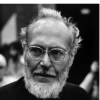W. Eugene Smith

W. Eugene Smith
William Eugene Smith, was an American photojournalist, renowned for the dedication he devoted to his projects and his uncompromising professional and ethical standards. Smith developed the photo essay into a sophisticated visual form. His most famous studies included brutally vivid World War II photographs, the clinic of Dr Schweitzer in French Equatorial Africa, the city of Pittsburgh, the dedication of an American country doctor and a nurse midwife, and the pollution which damaged the health of the residents of Minamata...
NationalityAmerican
ProfessionPhotographer
Date of Birth30 December 1918
CountryUnited States of America
An artist must be ruthlessly selfish.
The purpose of all art is to cause a deep and emotion, also one that is entertaining or pleasing. Out of the depth and entertainment comes value.
I am an idealist. I often feel I would like to be an artist in an ivory tower. Yet it is imperative that I speak to people, so I must desert that ivory tower. To do this, I am a journalist—a photojournalist. But I am always torn between the attitude of the journalist, who is a recorder of facts, and the artist, who is often necessarily at odds with the facts. My principle concern is for honesty, above all honesty with myself…
I am constantly torn between the attitude of the conscientious journalist who is a recorder and interpreter of the facts and of the creative artist who often is necessarily at poetic odds with the literal facts.
I can’t stand these damn shows on museum walls with neat little frames, where you look at the images as if they were pieces of art. I want them to be pieces of life!
Hardening of the categories causes art disease.
What's the best type of light? Why that would be available light... and by available light I mean any damn light is available.
With considerable soul searching, that to the utmost of my ability, I have let truth be the prejudice.
My camera, my intentions stopped no man from falling. Nor did they aid him after he had fallen. It could be said that photographs be damned for they bind no wounds. Yet, I reasoned, if my photographs could cause compassionate horror within the viewer, they might also prod the conscience of that viewer into taking action.
My pictures are complex and so am I. When I am almost symbolistic in writing, there is a more limiting difference’s of accepting, while I can be even more complex in the photographs and people can usually accept them within the framework of their own limitations or lack of limitations – there is no dictionary meaning… they can look up for the photographic image and allow it to confuse them.
Negatives are the notebooks, the jottings, the false starts, the whims, the poor drafts, and the good draft but never the completed version of the work The print and a proper one is the only completed photograph, whether it is specifically shaded for reproduction, or for a museum wall.
I think photojournalism is documentary photography with a purpose.
My pictures are complex and so am I.
What use having a great depth of field, if there is not an adequate depth of feeling?